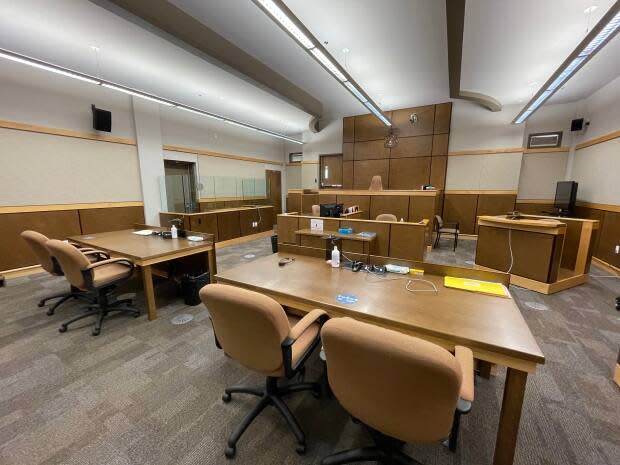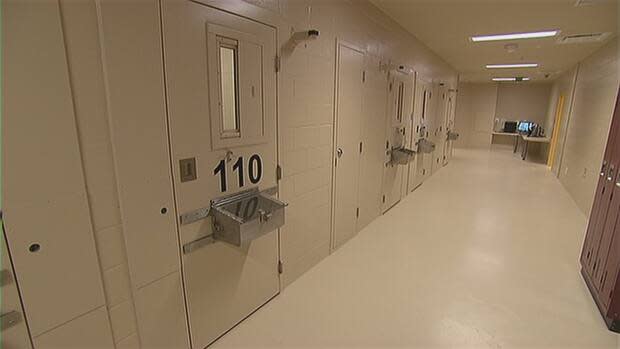Change in the way N.B. counts people in jail makes the correctional system seem more crowded

For the last year, New Brunswick government officials have said the province needs to build a new $38-million jail in the Fredericton region because the correctional system is stretched to capacity.
The government's figures show the male correctional system had an average of 512 people in it as of Dec. 31, which would be more than 40 people over the capacity of 470.
But in reality, provincial jails were only over capacity by eight people on average during that timeframe, a CBC analysis has found.
The stark difference stems from a quiet change the province has made to the way it calculates the number of people in provincial jails.
For years, the province has published figures in its annual report that capture the number of people actually sitting inside jails.
Now, the province is also counting the number of people who aren't physically in jail, but serving their sentences in the community — and who may have to go to jail if they breach the conditions placed upon them.
It's still the responsibility of the facility to look after these folks and in the event they have to bring them back, that issue is always there too. - Kris Austin
Public Safety Minister Kris Austin says the government's new method of counting the number of people in jail provides a more accurate picture of how many people fall under the system's watch.
"Whether they're actual inmates at the facility or if there are people that have been released with certain safeguards upon their release and being checked upon, it's still the responsibility of the facility to look after these folks, and in the event they have to bring them back, that issue is always there too."
But the government's numbers don't match up with the reality of the number of people who end up spending time in provincial jail, and makes it seem like the facilities are more crowded than they actually are.
In 2019-20, the government's numbers suggest the male correctional system was responsible for 478 people on average, which would be slightly over the capacity of 470.
New Brunswick's correctional math
Not all of those people breached their conditions and found themselves in jail.
In reality, only 436 people were in jail on average in 2019-20, far below the 470 capacity mark, according to numbers published in the department's own annual report.
The figures also show jails weren't at capacity during any other year dating back to 2012, when the department started publishing the average count of people in jail in its annual reports.
When presented with those findings, Austin doubled down on his government's figures.
"The numbers don't lie and they're very clear," he said. "We are over capacity."
'I don't need years of studies and research'
Experts say the government's new method is an unusual way of doing math.
"It's an improper way of calculating capacity, but it's actually a very problematic way of engaging with the goals of criminal justice and all the recent recommendations that have come out at all different levels in terms of how we should reform and improve criminal justice, and bring it closer to the justice part of criminal justice," said Adelina Iftene, a criminal law professor at Dalhousie University who has studied prison law and sentencing.
"Certainly, building more prisons is the opposite of that, and I would hazard to say that it doesn't serve anything but perhaps economical purpose."

Research shows that putting people in jail can be detrimental to their rehabilitation, Iftene said.
Instead, she said it's better for people to serve their sentences in the community, where they can access programming and support.
"They want to build more prisons anticipating that those numbers are going to be increasing, when the tendency and the recommendations is that all those numbers should be going down," Iftene said.
"That's highly problematic because it goes in the opposite direction that every single evidence-based study is showing."
An analysis published by the University of Toronto's Criminological Highlights publication in October also concluded that putting people behind bars has little impact on whether they'll re-offend.
The researchers reviewed more than 100 different studies, involving 4.5 million people sentenced in 15 countries.
When asked what studies or experts the government consulted when changing the way it calculates capacity, Austin said the evidence is "the numbers."
"I don't need years of studies and research on over capacity," he said. "The numbers are clear and that is why we're building this new facility."
The government also hasn't provided records that detail what kind of evidence it relied upon in deciding to build the jail.
CBC News filed an access to information request to the Department of Justice and Public Safety last year, asking for records that detail the need for a new correctional centre, including records that discuss the business case for a new jail. The request also asked for records detailing capacity issues within the current system.
But the department is withholding all of those records, including briefing materials about the proposed new jail, arguing they could reveal "advice, opinions, proposals or recommendations developed by or for the public body or a Minister of the Crown."
It's an example of the government refusing to provide records that could show how it reached major decisions, and what kind of data it relied upon in the process. CBC has appealed the decision.
"The experts are the numbers," Austin said, when asked about the evidence and experts his government consulted.
"The numbers speak for themselves."
Austin not swayed by experts' evidence
The province claims the average population of New Brunswick's jails has increased year over year since 2013-14.
But the number of people in jail between 2015-16 and 2018-19, prior to the pandemic, was largely stable from year to year, the figures show.
Jane Sprott, a criminology professor at Toronto Metropolitan University, pointed to Statistics Canada data that shows the number of people serving sentences inside New Brunswick's provincial jails has been on the decline for several years. Meanwhile, the number of people serving time on remand, where people spend time in custody before they're convicted of a crime, has been on the rise.

"I don't know why you'd want to expand that capacity to put more legally innocent people in prison," she said.
Sprott said there's a "volume of evidence" showing that imprisoning people is a failed policy, one that hasn't worked in the United States.
It's an argument that hasn't swayed the public safety minister.
"This concept that we should just not build any more jails and stop putting people in jail, look, it's a great concept," Austin said.
"But in reality, it just doesn't make sense. Because what we're doing is we're just going to allow people to continue to break laws with no repercussions and I don't see how that's going to make the public safer."


